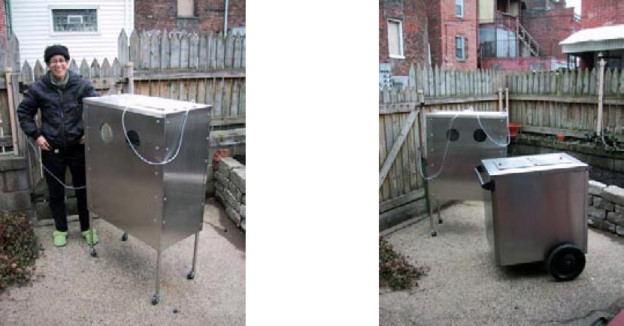Hays Woods is a privately owned 625 acre woodland on the bank of the Monangahela River in Pittsburgh. Developers plan a massive restructuring of the landmass and obliteration of the existing ecology through mountaintop removal of its remaining coal, and eventual construction of a racetrack and gambling casino along with other commercial development. Few people in the area know the woodland exists, as it is isolated from the surrounding inhabited communities due to a highway interchange and railroad tracks.An intricately drawn city boundary reaches across the river and lassoos this plot of land for Pittsburgh’s tax base (and set asides).
I am making three mobile oxygen bars that will make short visits to public gathering places in Pittsburgh neighborhoods and nearby towns in the spring of 2005. The stainless steel oxygen bars will contain mini- forests–Hays Woods in microcosm. Each generates a small, concentrated batch of contained o2 that can be snorted via attached tubing or by lifting the lid and sticking your head in. Signage and a map printed on the outside of each o2 bar will link its small, microcosmic air-cleansing operation to the larger air-cleansing operation continuing at Hays Woods, unbeknownst to most Pittsburgh area residents, and to how health issues associated with air pollution can be alleviated by urban forests (which fix carbon, generate oxygen and filter particulates). The bars will also distribute information on the call for proposals that my collaborators Tom and Connie Merriman are organizing, inviting area residents to propose possible alternative futures for Hays Woods.
The woods filters Pittsburgh’s dirty air through the abundant surface area of its leaf mass and bark textures, as well as through its processes of transpiration and photosynthesis. Allegheny County, along with 20 other counties in PA has unacceptably high quantities of airborne soot, some of which arrives on the prevailing northwest wind coming from Ohio coal power burners, and some of which is generated by more local sources. Trees filter air mechanically by catching particulates on the surfaces of their leaves and branches, from which the soot and dust and toxins are then washed to the ground by rain. One study showed dust counts reduced by 75% downwind of a forest. In addition, photosynthesis removes nitrogen oxides, airborn ammonia, sulfur dioxide and ozone through chemical transpiration, while the atmospheric co2 load is reduced through trees’ processes of transpiration, taking in co2 and giving back oxygen.
A number of questions are at stake for me with this project separate from the urgency of “saving Hays” as conservation of ecological diversity and a stay against development. One has to do with private property. Most people respond to the difficulty of interfering with development with shrugs, what can you do, he owns the land. But a network of regulations as well as tax incentives which amount to public interest and public money typically surround any development plan, and rhetoric is deployed on all sides to describe benefits to the public. Thinking about this public/private ambiguity and the necessity of communities to take an active role in determining the future structure of their physical environment no matter how private a matter it seems to be, is crucial. There is no obvious community to care in this case, separated as Hays Woods is from the heart of Pittsburgh. A primary goal of the Hays Woods Project is to generate a sense of public ownership in this resource. Although the land is privately owned, plans for its development are rationalized by notions of public good, based on speculative economic models and faulty claims for environmental remediation that would solve a “problem” by effectively removing the site itself.
The bars will not be accompanied initially, but left for short periods in public places, inviting curiosity and investigation without pre-definition. However, at some point in each o2 bar visit I hope to engage in conversation with people who indicate interest in the objects.
Another question for me is the typically limited demographic of environmental activists, which, in Pittsburgh as in many other areas, is largely white and middle class. Rather than bemoaning why people of color and working class people don’t tend to get involved in environmental battles framed by ideas of conservation, I am curious to investigate lines of connection that do matter, such as environmental health. The issues involved in saving Hays are health and safety issues.
I hope that these objects will work not only as information kiosks, and as visual/experiential links between health and environmental issues, but also as excuses to engage in conversations. I am not at all interested in proselytizing or attempting to recruit environmental advocates, but in learning more about how a range of people from different economic and racial backgrounds think about land use, collective ownership, and related issues of environmental justice. While the future of Hays Woods is of immediate concern, the broadening of environmental thinking to include concerns that low-income people recognize as relevant to their lives extends beyond whether the woods remains or not. I am curious to see if these bars might serve as excuses for public conversations, and where these conversations might lead.
